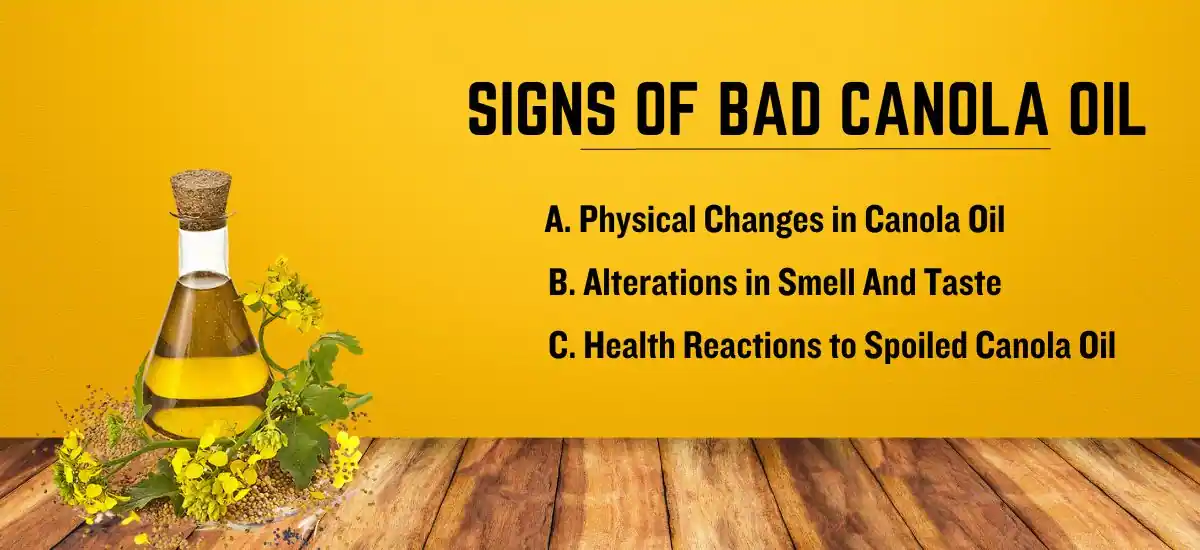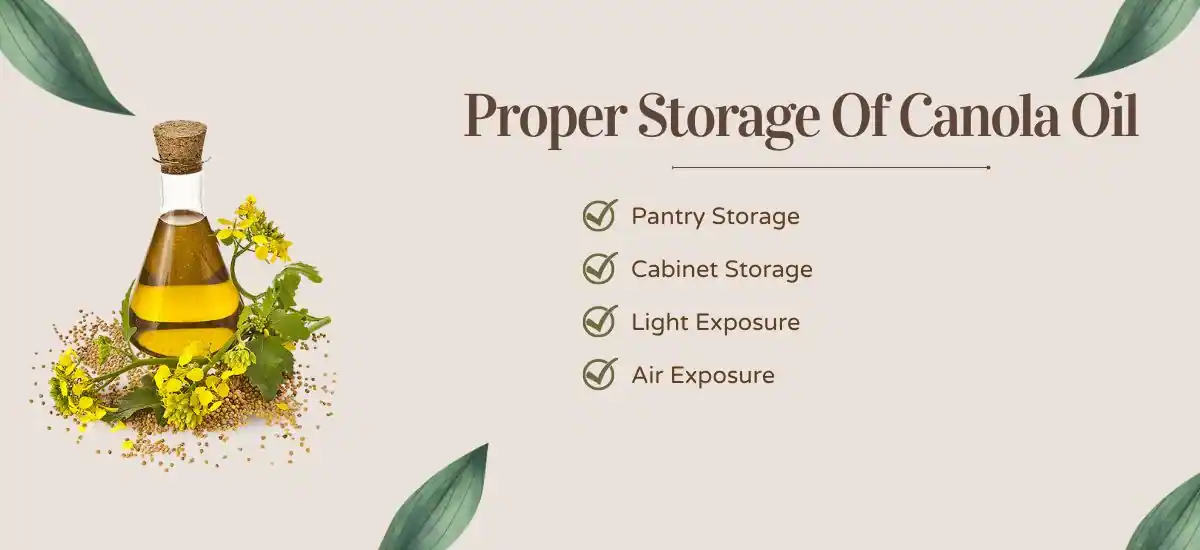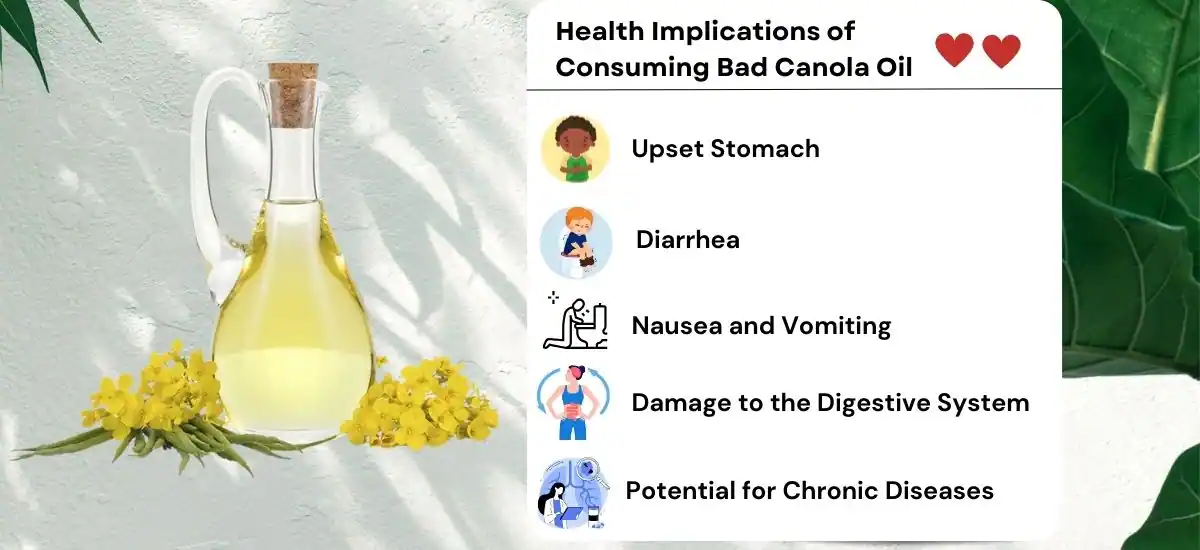Yes, Canola oil does go bad. While it has a relatively long shelf life, improper storage, such as exposure to heat, light, and air, can cause it to go rancid. Unopened Canola oil can typically last for up to two years, while an opened bottle has a shelf life of approximately one year. It’s essential to look for signs of spoilage such as changes in color, smell, and taste before using the oil.
Nutritional Facts Of Canola Oil
A. Detailed Breakdown of Nutritional Content
- Saturated Fat
- Monounsaturated Fats
- Omega-3 Fatty Acids
- Omega-6 Fatty Acids
- Calories
B. Health Benefits of Canola Oil
- Heart Health
- Anti-inflammatory Properties
- Skin Health
- Eye Health
C. Risks Associated with Overconsumption of Canola Oil
- Increased Caloric Intake
- Potential Weight Gain
- Possible Influence on Inflammation
Signs Of Bad Canola Oil

A. Physical Changes in Canola Oil
- Change in Color: Fresh Canola oil usually has a golden-yellow color. If the oil starts to darken significantly, it may be a sign of oxidation and spoilage.
- Cloudiness or Murkiness: Fresh Canola oil should be clear. If the oil appears cloudy or murky, it could indicate that the oil has started to degrade or that moisture has invaded the bottle.
- Presence of Mold or Particles: Any visible mold or foreign particles floating in the oil is a surefire sign of spoilage. This could be due to contamination or prolonged storage beyond the oil’s shelf life.
B. Alterations in Smell And Taste
- Rancid or Unpleasant Odor: Fresh Canola oil smells light, almost neutral. If the oil develops a strong, rancid, or unusual odor, it’s best to throw it away as this indicates spoilage.
- Bitter or Unusual Taste: Like its smell, Canola oil has a relatively mild taste. A bitter or otherwise off-putting flavor is a clear sign that the oil should no longer be consumed.
C. Health Reactions to Spoiled Canola Oil
- Nausea or Upset Stomach: If you’ve consumed spoiled Canola oil and begin to feel nauseous or experience an upset stomach, it could be a reaction to the spoiled oil.
- Diarrhea or Digestive Discomfort: Likewise, experiencing diarrhea or other forms of digestive discomfort after consumption can be a sign that the oil was spoiled.
- Allergic Reactions or Skin Irritations: Although less common, some people may have allergic reactions to spoiled Canola oil. These reactions can include skin irritations, like redness, itching, or hives. If you notice these symptoms after using the oil, it’s best to discontinue its use immediately.
Proper Storage Of Canola Oil

A. Ideal Locations for Canola Oil Storage
- Pantry Storage: The pantry is an excellent place to store Canola oils, especially if it’s cool and dark. This location helps in maintaining the oil’s quality for a longer period.
- Cabinet Storage: Cabinets, particularly those away from the stove or oven, can also be good storage locations. Like the pantry, cabinets provide a dark environment that can help protect the oil from light exposure.
- Avoidance of Direct Sunlight and Heat: Canola oils should never be stored in direct sunlight or near heat sources, as these conditions can speed up the oil’s degradation process, leading to early spoilage.
B. Factors Influencing Canola Oil Storage
- Temperature: Canola oils should be stored at a cool temperature, ideally below 70 degrees Fahrenheit. Higher temperatures can make the oil go rancid more quickly.
- Light Exposure: Light, especially sunlight, can degrade Canola oils over time. Therefore, it’s important to store the oil in a dark location.
- Air Exposure: Once a bottle of Canola oils is opened, it’s exposed to air, which can quicken the oxidation process. Hence, it’s crucial to seal the oil container properly after each use.
C. Best Practices for Prolonging Canola Oil Shelf Life
- Proper Sealing of Canola Oil Container: Always ensure that the Canola oils container is tightly sealed after each use to minimize air exposure.
- Regular Checking for Signs of Spoilage: Regularly check the oil for any signs of spoilage such as changes in color, smell, or taste. If you notice any of these signs, it’s best to discard the oil.
- Consideration for Refrigeration in Certain Climates: In warmer climates or during summer months, you might consider refrigerating Canola oils. However, this can cause the oil to become cloudy and thicken, but it will return to its normal state once it reaches room temperature.
Health Implications of Consuming Bad Canola Oil

A. The Impacts on Digestion
- Upset Stomach: Consuming rancid Canola oils can upset your stomach, leading to discomfort, bloating, and a general feeling of being unwell.
- Diarrhea: Spoiled oil can irritate the lining of the gut, leading to diarrhea. This can lead to dehydration if not managed properly.
- Nausea and Vomiting: The unpleasant taste and smell of spoiled oil can induce a feeling of nausea and, in some cases, result in vomiting.
B. The Potential for Food Poisoning
- Symptoms of Food Poisoning: If the Canola oils has been contaminated with harmful bacteria, it can lead to food poisoning. Symptoms include stomach cramps, vomiting, diarrhea, and fever. These symptoms can last from a few hours to several days.
- Severity of Food Poisoning from Spoiled Oil: The severity of food poisoning from consuming bad Canola oils can vary from mild to severe, depending on the level of contamination and the individual’s overall health.
C. Long-term Health Risks
- Damage to the Digestive System: Regular consumption of spoiled Canola oils can lead to chronic inflammation of the gut, which can cause long-term damage.
- Potential for Chronic Diseases: Over time, regular intake of spoiled food, including rancid oil, can contribute to the development of chronic diseases such as heart disease and cancer.
- Impact on Immune System Health: The immune system can be negatively affected by the consumption of spoiled Canola oils. Regular intake can reduce the immune system’s efficiency, rendering the body more susceptible to infections and diseases.
Comparing Canola Oil To Other Oils
A. Shelf Life Comparison: Canola Oil Versus Olive Oil
- Lifespan of Unopened Canola Oil Versus Olive Oil: Unopened Canola oils typically lasts for about two years, while extra virgin olive oils can last up to three years if stored properly.
- Lifespan of Opened Canola Oil Versus Olive Oils: Once opened, Canola oils can last for up to a year, while olive oils has a shorter lifespan of about six months.
- Factors Affecting Shelf Life: Both Canola and olive oil’s shelf life can be influenced by factors such as exposure to light, heat, and air.
B. Shelf Life Comparison: Canola Oil Versus Sunflower Oil
- Lifespan of Unopened Canola Oil Versus Sunflower Oils: Unopened Canola oils and sunflower oil have a similar shelf life of about two years.
- Lifespan of Opened Canola Oil Versus Sunflower Oil: Opened Canola oils typically lasts a year, while sunflower oils can last up to two years if stored properly.
- Factors Affecting Shelf Life: Like Canola oils, the lifespan of sunflower oils is influenced by factors such as light, heat, and air exposure. However, sunflower oil generally has a more stable shelf life due to its higher vitamin E content, which acts as a natural antioxidant.
Frequently Asked Question
Q1. Can Canola Oils last past its expiry date?
Ans. Yes, it can last past its expiry date if it has been stored correctly. The expiry date is a quality indicator, and oils stored in a cool, dark place and correctly sealed can last months beyond this date. However, always check for signs of spoilage before using it.
Q2. How to extend the life of Canola Oils?
Ans. To extend the shelf life of Canola oils, store it in a cool, dark place, away from heat and sunlight. Make sure the oil is always tightly sealed when not in use to limit exposure to air, which can speed up the oxidation process.
Q3. Is it safe to cook with older Canola Oils?
Ans. It depends on the condition of the oil. If the oil shows no signs of spoilage such as changes in color, smell, or taste, it should be safe to use. However, if the oil appears murky, smells rancid, or tastes unusual, it’s best to discard it.
Q4. What to do with expired Canola Oils?
Ans. If Canola oils has expired and shows signs of spoilage, it’s best to dispose of the oils. Pour it into a sealable non-recyclable container and throw it in the trash. Never pour oil down the sink, as it can cause plumbing issues. Expired oil that doesn’t show signs of spoilage can be used for non-culinary purposes such as lubrication, making soap, or oiling tools.
You May Also Like:
